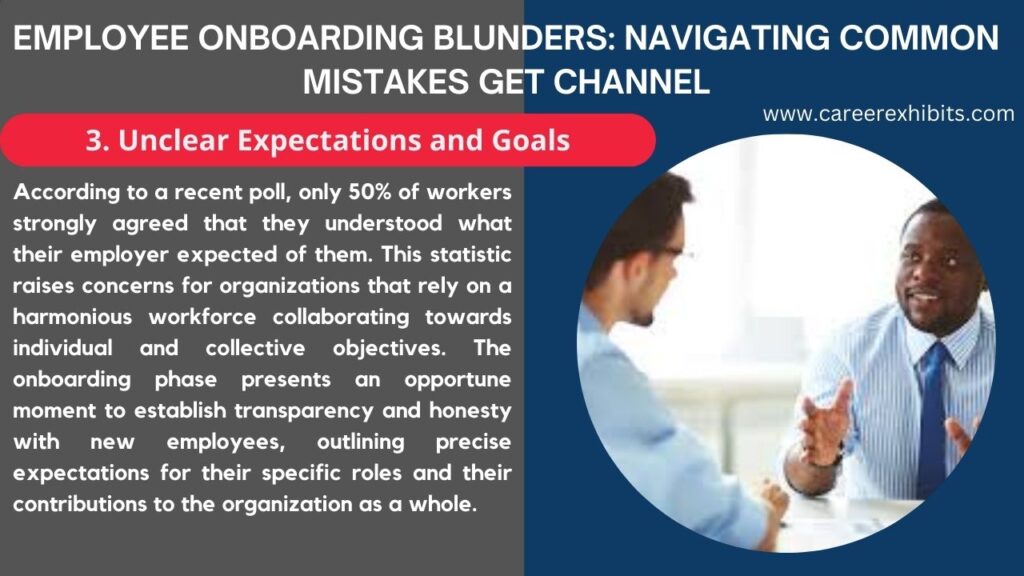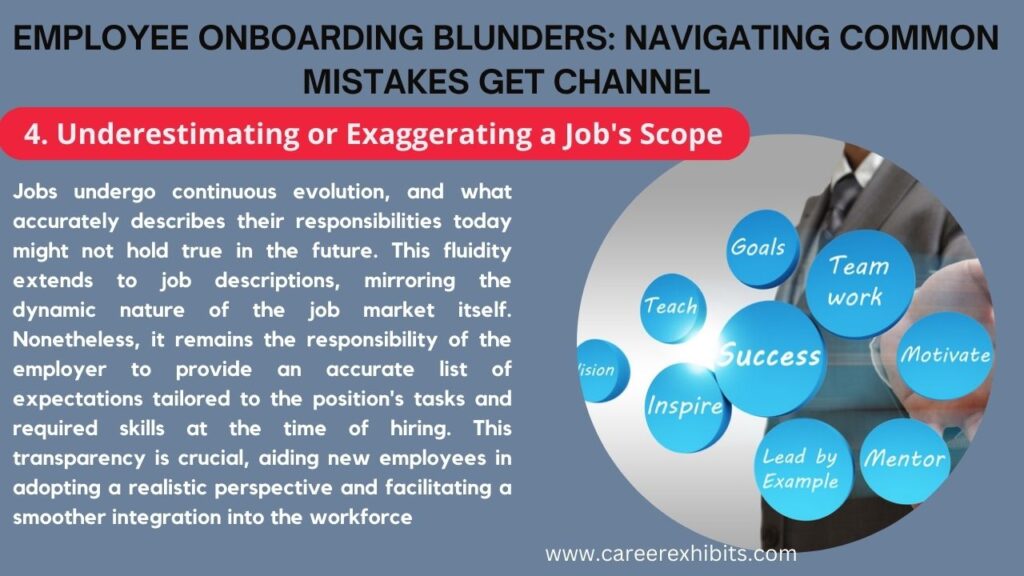Introduction: Employee Onboarding
The process of welcoming new employees into an organization is a pivotal moment that sets the tone for their entire experience within the company. Employee onboarding is more than just paperwork and introductions; it’s an opportunity to foster a sense of belonging, provide clarity about roles and responsibilities, and establish the foundation for a productive and fulfilling tenure. However, like any journey, the path to effective onboarding is riddled with potential pitfalls. In this guide, we’ll explore the common mistakes that often arise during employee onboarding, empowering both HR professionals and new hires to recognize and avoid these stumbling blocks. By understanding these challenges and learning how to overcome them, organizations can create an onboarding process that not only welcomes employees but propels them toward success from day one.

Join us as we delve into the world of employee onboarding, uncovering the missteps that can hinder a smooth integration process. From communication breakdowns to inadequate training, we’ll shed light on the various aspects of onboarding where errors commonly occur. More importantly, we’ll equip you with the knowledge and strategies needed to bypass these pitfalls, ensuring that each new employee’s onboarding experience is a seamless and positive introduction to their new professional home. So, let’s embark on this journey of discovery, as we unravel the intricacies of effective onboarding and empower both employers and employees to create lasting, productive relationships.
1. Disorganization and Procrastination
The passage discusses the importance of avoiding procrastination and disorganization in the employee onboarding process for successful organizations. It emphasizes the need for effective planning and organization to ensure that new hires are efficiently integrated into their roles.

Many successful organizations start their onboarding process well before a new employee’s first day of work, with approximately 83% following this practice. This proactive approach enables the company to distribute essential tasks and activities across a defined timeframe, ensuring that the new hire becomes fully prepared and productive sooner.
To achieve this, employers should steer clear of procrastination and disorganization. Instead, they should formulate a comprehensive schedule and strategy for the employee onboarding process. This plan should outline the specific requirements for each day, helping the new employee understand what is expected and aiding in their smooth transition into the organization.
However, this doesn’t mean overwhelming the new hire with an excessive amount of paperwork and tasks as they start their job. Instead, employers should strike a balance in the onboarding process to optimize productivity. This involves skillfully developing the new employee’s skills and knowledge without resorting to hastily organized training sessions.
Modern technology offers valuable solutions to facilitate this balance. Human Resources (HR) departments can leverage onboarding platforms designed to streamline the entire process. These platforms grant new employees both mobile and desktop access to various training sessions, reference materials, questionnaires, and necessary paperwork. This technology ensures that the new hire can conveniently complete essential tasks such as benefits and tax forms without consuming valuable onboarding time that would be better spent on more valuable tasks.
Successful organizations prioritize organized and timely onboarding processes to avoid procrastination and disorganization. An effective plan is essential, striking a balance between training and productivity. Technology, such as onboarding platforms, can significantly aid in this endeavor by providing efficient tools for both HR and new employees.
2. Unprofessional or Bad Initial Impressions
The passage highlights the significance of first impressions in the onboarding process and the potential long-term impact they can have on an employee’s experience within an organization.

The saying “you don’t get a second chance to make a first impression” holds true in the context of welcoming new employees. Although it’s not necessary for organizations to go to extravagant lengths, having everything well-prepared is essential. Consider a scenario where a new employee joins a workplace where everyone is already familiar with each other and the daily routines. This situation can be quite overwhelming for the new hire if things aren’t properly organized.
If the new employee is greeted with a disorganized workstation, a malfunctioning computer, a lack of necessary office supplies, and missing essential technology subscriptions for their role, this initial encounter will leave a negative impression. Such a negative first impression has the potential to cast a shadow over the entire duration of the employee’s tenure. To ensure a smooth transition for the new hire, all aspects of their integration into the organization need to be meticulously arranged.
Human Resources (HR), management, and coworkers all share a responsibility in preparing for the arrival of a new employee. This collective effort is crucial to guaranteeing that the new employee’s onboarding experience is seamless, enabling them to acclimate to their new role and the organization’s culture without any setbacks. While every stage of an employee’s journey within the organization holds significance, the impression created during the onboarding phase can profoundly influence both the employee’s trajectory and the organization’s overall success for years to come.
The passage underscores the importance of crafting a positive first impression during the onboarding process. A well-organized and welcoming introduction can significantly impact the employee’s overall experience and subsequently influence the organization’s performance over an extended period.
3. Unclear Expectations and Goals
According to a recent poll, only 50% of workers strongly agreed that they understood what their employer expected of them. This statistic raises concerns for organizations that rely on a harmonious workforce collaborating towards individual and collective objectives. The onboarding phase presents an opportune moment to establish transparency and honesty with new employees, outlining precise expectations for their specific roles and their contributions to the organization as a whole.

Considering that it typically takes around six months for a new hire to feel fully integrated and well-prepared for the challenges of their position, employers should capitalize on this period to consistently assess the employee’s progress. This involves reinforcing crucial concepts and soliciting feedback to identify areas for enhancement. The Better works Engager’s platform stands as a potential asset for employers seeking a highly efficient, and even automated, system. This platform offers real-time insights into viewpoints that could potentially shape the entire spectrum of the employee experience.
The poll’s findings reveal that a mere 50% of workers grasp their employers’ expectations. To counter this, onboarding serves as an optimal phase to establish openness and clarity. Employers have an invaluable six-month window to monitor progress, reinforce vital principles, and gather feedback. The Betterworks Engager’s platform emerges as a promising tool for organizations aiming to implement a streamlined, possibly automated, solution that provides real-time insights capable of shaping the overall employee experience.
4. Underestimating or Exaggerating a Job’s Scope
Jobs undergo continuous evolution, and what accurately describes their responsibilities today might not hold true in the future. This fluidity extends to job descriptions, mirroring the dynamic nature of the job market itself. Nonetheless, it remains the responsibility of the employer to provide an accurate list of expectations tailored to the position’s tasks and required skills at the time of hiring. This transparency is crucial, aiding new employees in adopting a realistic perspective and facilitating a smoother integration into the workforce.

When a new employee joins with the anticipation of fulfilling specific, defined roles, any unexpected changes or surprises can be perceived as misleading. Few actions are as effective at unsettling a new employee as making them feel deceived. Therefore, it’s imperative to uphold transparency in job descriptions to establish trust and prevent any sense of manipulation.
The adaptability of job roles and descriptions parallels the ever-changing job market. Employers must deliver precise expectations aligned with the position’s tasks and skill requirements at the point of hiring. This honesty fosters a seamless transition for new employees and avoids any feelings of being misled, which could otherwise disrupt their onboarding experience.
5. No official timetable or procedure
Revisiting the importance of thorough preparation, the onboarding process stands as a pivotal factor in the overall success of an organization. Its effectiveness hinges on intentional planning, demanding a strategic approach. Onboarding, therefore, should encompass a blend of educational elements, relationship cultivation, and networking opportunities. This multifaceted approach aims to accelerate the integration of a new employee while maintaining a comprehensive and thorough process.

Formal protocols play a vital role in laying the groundwork as onboarding unfolds and a new hire familiarizes themselves with their role within the organization. However, the presence of formality should not be misconstrued as inflexibility. Adapting to diverse learning paces and the capacity to absorb new information necessitates a significant level of flexibility. Collaborating with colleagues, management, and session leaders is crucial in effectively preparing for upcoming onboarding sessions. Additionally, ensuring the provision of supplementary materials to new hires is essential. These materials serve as invaluable reference points, reinforcing the knowledge gained throughout the onboarding journey.
The significance of meticulous preparation remains paramount. Onboarding functions as a linchpin in an organization’s triumphant, demanding strategic planning. A holistic onboarding approach that incorporates education, relationship cultivation, and networking is essential for swift and comprehensive employee integration. While formal procedures establish the foundation, adaptability is key to accommodating diverse learning styles. Collaboration with various stakeholders is integral for successful onboarding events, and the provision of supplementary resources bolsters the retention of acquired knowledge.
6. Information Flood at Once
As mentioned earlier, the initial days, weeks, or even months in a new job can be quite daunting. Consequently, it is imperative to distribute information in a balanced manner to prevent overwhelming a new hire with an excessive amount of data all at once. While the desire to provide copious amounts of information to expedite the new employee’s integration process might be strong, this approach often yields the opposite outcome.

Overloading a new team member with too much information tends to result in overwhelming them to the extent that they absorb very little, if any, of the crucial details about their role and the organization.
The early stages of a new job can be overwhelming, underscoring the importance of a well-paced information distribution strategy. While the temptation to inundate new hires with information may exist, this approach often backfires, leading to a lack of absorption of critical information due to overload.
7. Neglecting Cultural Adjustment
When an employer hires an individual, it signifies their recognition of the person’s potential and their belief that, given time, they will become a valuable and productive contributor to the organization. However, this doesn’t imply that every new employee will immediately adapt to the culture and atmosphere of their new workplace. Much like other aspects of life, comprehending and assimilating into an organization’s culture is a learned behavior that develops through experience and repetition.

Frequently, coworkers serve as the most effective channels for conveying information about an organization’s culture, policies, and procedures. While classroom instruction and reference materials can certainly offer bullet points and summaries, they fall short of providing actual, firsthand experience. It’s beneficial to encourage coworkers to volunteer their time and guidance to new hires. This involves familiarizing them with the daily routines, expediting their grasp of the organization’s culture, and fostering a sense of acceptance. This approach proves particularly advantageous if a new hire, for instance, has spent their entire career in smaller companies but now faces the unfamiliar territory of a much larger workplace and workforce.
Hiring an individual signifies recognition of their potential for contribution. Yet, immediate alignment with the organizational culture is not a given. Just like any acquired skill, adapting to a culture involves learning through experience. Coworkers play a pivotal role in transmitting cultural insights, surpassing the efficacy of instructional materials. Engaging coworkers to guide new hires through the daily operations expedites their assimilation, which is especially valuable when transitioning from a smaller to a larger work environment.
8. Failing to Provide Management Support and Feedback
A supervisor’s desk is invariably cluttered with an array of projects, each demanding focused attention for successful completion. This underscores the reality that managers already grapple with demanding schedules and minimal available time. Consequently, dedicating any of their valuable time to tasks that lie beyond their usual responsibilities might be perceived as an additional burden on an already hectic routine.

Nonetheless, due to its significance for both the individual and the organization, onboarding should be considered an integral aspect of these customary duties. It holds as much importance to an organization’s triumph as financial reports and customer service do. This predicament underscores the pressing necessity for meticulous organization and advanced scheduling of onboarding activities. This approach provides supervisors with ample time to incorporate one-on-one sessions with new hires or even seamlessly integrate onboarding sessions into their schedules.
As crucial and valuable as Human Resources (HR) is to the onboarding process, it cannot serve as a substitute for the distinctive insights and impactful guidance that a manager can offer a new team member. This distinctive perspective adds value to the onboarding experience.
A manager’s desk is typically inundated with numerous tasks, signifying their busy routine. Despite this, recognizing onboarding as a core responsibility akin to other vital tasks is pivotal. To address this challenge, meticulous organization and proactive scheduling are imperative. This approach allows supervisors to incorporate onboarding-related meetings and sessions into their schedules effectively. While HR’s role is crucial, the distinctive guidance a manager provides is invaluable in shaping the onboarding journey.
9. Confusing Onboarding With Orientation
Frequently confused as interchangeable terms, “orientation” and “onboarding” are distinct concepts. Orientation, in fact, is just a specific facet of the broader onboarding process and does not encapsulate the entirety of onboarding. Precisely, orientation denotes a singular event that transpires at some point during the onboarding process. This event allows the new hire to complete essential administrative tasks, such as paperwork, which are more procedural in nature than centered around the organization’s culture and overarching goals.

Human Resources (HR) can effectively streamline orientation into a condensed session, typically occurring over a morning or afternoon. On the other hand, onboarding extends beyond this singular event. It is an ongoing process that unfolds over time, progressively immersing the new employee in the organization’s policies, protocols, and cultural nuances.
To sum up, orientation and onboarding are often mistakenly interchanged, but they possess distinct meanings. Orientation represents a specific event within the broader onboarding process, focused on administrative tasks. HR can efficiently condense orientation into a short timeframe. Conversely, onboarding is a continuous process that encompasses various elements and gradually integrates the new employee into the organization’s culture and practices.
10. Promising something, tangible or intangible
Promising and delivering a positive onboarding experience to new employees is crucial for their engagement and success within the organization. Setting clear expectations and offering tangible and intangible benefits can contribute to a smooth transition and a strong sense of belonging. Here’s how you could phrase such promises:

“Welcome to our team! As part of our commitment to your growth and satisfaction, we’re excited to offer you the following during your onboarding and orientation process:
- Comprehensive Training: You’ll receive in-depth training tailored to your role, ensuring you have the tools and knowledge to excel from day one.
- Mentorship and Support: You’ll be paired with an experienced mentor who will guide you through your initial weeks, providing valuable insights and helping you navigate the organization.
- Open Communication: We believe in transparent communication. Your feedback and ideas are important to us, and we’re dedicated to fostering an environment where your voice is heard.
- Professional Development: We’re invested in your long-term growth. Through workshops, seminars, and continuous learning opportunities, you’ll have the chance to enhance your skills and progress in your career.
- A Welcoming Environment: You’ll become part of a diverse and inclusive community where you’ll be valued for your unique contributions. Our team prides itself on its collaborative and supportive atmosphere.
- Health and Well-Being: We care about your well-being. You’ll have access to wellness programs and resources that promote a healthy work-life balance.
- Recognition and Rewards: Your hard work won’t go unnoticed. We have a recognition program in place to celebrate your achievements and dedication.
- Engaging Projects: You’ll be involved in exciting projects that challenge you and allow you to showcase your talents.
- Company Culture: Get ready to experience our vibrant company culture through team-building activities, social events, and opportunities to connect with colleagues.
- Career Pathway: We’re committed to helping you build a fulfilling career. Your success is important to us, and we’ll work together to outline a clear path for your advancement within the company.
We’re thrilled to have you on board and look forward to embarking on this journey together. Your contributions will play a vital role in our shared success.”
Remember, it’s important to not only make promises but also fulfill them consistently. This will not only help in retaining and engaging employees but also in building a positive employer brand that attracts top talent.
11. Isolating a new hire from their co-workers
Isolating a new hire from their co-workers during the onboarding and orientation process is counterproductive and can have negative consequences for their integration and overall experience within the organization. Encouraging a sense of belonging and fostering relationships with colleagues is crucial for a successful onboarding journey.

Isolation during this critical phase can lead to:
- Reduced Engagement: When new hires feel isolated, they may become disengaged and less motivated to contribute effectively to the team.
- Missed Learning Opportunities: Interaction with co-workers allows new employees to learn about the company culture, team dynamics, and unwritten rules that contribute to their overall understanding of the organization.
- Limited Collaboration: Isolating new hires prevents them from building relationships that are essential for effective collaboration. This can hinder teamwork and the sharing of ideas.
- Diminished Confidence: Without the support of co-workers, new hires might struggle to build their confidence and navigate their roles, leading to slower progress and potential frustration.
- Retention Challenges: Feeling isolated and disconnected can lead to a higher likelihood of new hires leaving the organization within the first few months.
To create a positive onboarding experience:
- Encourage Interaction: Foster a culture of inclusivity by encouraging existing team members to interact and welcoming new hires. Arrange team lunches, introductions, and icebreaker activities.
- Buddy System: Pair new hires with a buddy or mentor who can guide them through their initial weeks, answer questions, and provide insights into the company culture.
- Cross-Functional Exposure: Provide opportunities for new hires to work with different teams or departments, helping them broaden their network and understand the company’s larger ecosystem.
- Regular Check-ins: Schedule regular check-ins with the new hires to gauge their progress, address any concerns, and ensure they feel supported.
- Open Communication Channels: Make sure new hires have access to communication tools that enable them to reach out to colleagues easily.
Remember, the goal of onboarding is to help new employees become productive and engaged members of the team as quickly as possible. This can only be achieved by promoting interaction, collaboration, and a sense of belonging from the very beginning
12. Micromanaging the onboarding process
Implementing a micromanaging approach during the onboarding and orientation process can hinder the growth and development of new hires and negatively impact the overall effectiveness of the onboarding experience. Instead of fostering independence and confidence, micromanagement can lead to several adverse outcomes:

- Stifled Creativity: Micromanaging can discourage new employees from thinking outside the box and contributing innovative ideas, as they may feel pressured to adhere strictly to predefined processes.
- Reduced Ownership: Constant oversight can prevent new hires from taking ownership of their tasks and responsibilities, leading to a lack of accountability and motivation.
- Increased Stress: Excessive scrutiny can create unnecessary stress for new employees, making it harder for them to adapt to their new environment and perform optimally.
- Limited Learning: Micromanagement can restrict the opportunities for new hires to learn from their mistakes, which is an essential part of the learning process.
- Slow Adaptation: New employees may take longer to adapt to their roles and become productive if they are constantly directed and controlled, as they don’t have the chance to learn and grow on their own.
To promote a healthier onboarding experience:
- Provide Clear Guidelines: Instead of micromanaging, offer clear guidelines and expectations for tasks and projects, allowing new hires to understand what is required while having the freedom to execute in their own style.
- Encourage Autonomy: Empower new employees to make decisions and take ownership of their work. This encourages a sense of responsibility and boosts their confidence.
- Open Communication: Maintain open lines of communication so that new hires can ask questions, seek guidance, and share their progress without feeling like they’re being constantly monitored.
- Feedback and Support: Offer constructive feedback and support when needed, rather than constantly checking in on their progress.
- Set Milestones: Establish achievable milestones for new hires to work towards. This can help them track their progress and demonstrate their capabilities.
- Build trust. Trust your new hires to apply their skills and judgment to their tasks. Trust is a fundamental factor in employee engagement and growth.
Remember, onboarding is an opportunity to introduce new employees to the organization’s culture, values, and processes, while also allowing them to showcase their skills and potential. A balanced approach that combines guidance with autonomy can lead to a more positive onboarding experience and better long-term outcomes.
13. Providing unhelpful, inconsistent information
Providing unhelpful and inconsistent information to new onboarding employees can create confusion, frustration, and a lack of confidence in their new role and the organization. To ensure a smooth and effective onboarding experience, it’s crucial to offer accurate and consistent information:

- Confusion and Misunderstanding: Unhelpful information or conflicting instructions can lead to misunderstandings about job responsibilities, company policies, and processes.
- Doubt in Company Credibility: Inconsistent information can erode a new hire’s trust in the organization’s professionalism and ability to communicate effectively.
- Reduced Productivity: When new employees are unsure about how to perform their tasks due to conflicting information, their productivity may suffer.
- Loss of Confidence: Receiving contradictory guidance can make new hires doubt their abilities and decisions, potentially undermining their confidence.
- Negative Impact on Culture: Inaccurate or inconsistent information about company values, mission, and culture can lead to a misunderstanding of the organizational ethos.
To ensure a positive onboarding experience:
- Centralized Information: Maintain a centralized repository of accurate and up-to-date onboarding materials, including job descriptions, policies, and procedures.
- Consistent Training: Provide consistent training sessions to all new hires, ensuring they receive the same information regardless of who is conducting the training.
- Assigned Mentor or Buddy: Assign a mentor or buddy to each new hire who can provide guidance and address any questions, helping to ensure consistent information.
- Regular Updates: As processes or policies change, ensure that all new hires are informed promptly and given the necessary resources to adapt.
- Feedback Mechanism: Establish a mechanism for new hires to provide feedback on the onboarding process, allowing you to identify and rectify any inconsistencies.
- Open Communication: Encourage new employees to ask questions and seek clarification whenever they encounter conflicting or confusing information.
Remember, a well-structured and consistent onboarding process is essential for setting a positive tone in a new employee’s journey with the company. By providing accurate and helpful information, you lay the foundation for their success and integration into the organization.
14. Assuming a new hire’s needs and expectations
Assuming a new hire’s needs and expectations rather than gathering authentic feedback can lead to misunderstandings, dissatisfaction, and a missed opportunity for creating a tailored and effective onboarding experience. To ensure the successful integration of new employees, it’s important to actively seek and listen to their feedback.

- Misalignment with Reality: Assuming without seeking feedback can result in an onboarding process that doesn’t address the actual needs and expectations of new hires, leading to frustration and disengagement.
- Missed Improvement Opportunities: Without genuine feedback, the organization might overlook valuable insights that could lead to enhancements in the onboarding process.
- Lost Productivity and Time: A mismatch between assumptions and actual needs can slow down the new hire’s ramp-up time, impacting their ability to contribute effectively.
- Negative Perception: New hires may perceive the organization as indifferent to their individual needs, affecting their perception of the company culture and commitment to their success.
To create a more personalized and effective onboarding experience:
- Feedback Surveys: Conduct regular surveys to gather insights from new hires about their onboarding experience, focusing on what worked well and what could be improved.
- One-on-One Check-Ins: Schedule one-on-one meetings with new employees to discuss their experiences and any challenges they’re facing during the onboarding process.
- Open-Door Policy: Maintain an open-door policy that encourages new hires to share their thoughts and concerns openly, fostering an environment of trust and communication.
- Tailored Approach: Customize the onboarding process based on the feedback received, adapting to individual preferences and learning styles.
- Continuous Improvement: Use the feedback collected to continually refine the onboarding process, ensuring it remains relevant and effective.
- Listening Sessions: Organize feedback sessions where new hires can openly express their thoughts and ideas about their onboarding journey.
Remember, each new employee brings a unique set of skills, experiences, and expectations. By actively seeking their input and feedback, you can create an onboarding process that not only meets their needs but also demonstrates the organization’s commitment to their success
15. Don’t throw a new hire into the deep end of the pool and expect them to swim
Don’t throw a new hire into the deep end of the pool and expect them to swim. A successful onboarding process requires gradual support and guidance to help new employees acclimate and contribute effectively.

- Overwhelm and Stress: Placing new hires in challenging situations without proper orientation can lead to feelings of overwhelm, stress, and a lack of confidence.
- Reduced Productivity: When new employees are left to figure things out on their own, it can hinder their productivity as they struggle to navigate unfamiliar territory.
- Missed Learning Opportunities: Without proper guidance, new hires might miss out on valuable learning experiences and insights that can aid their growth.
- Demotivation: Being thrust into a role without sufficient preparation can demotivate new hires, making them question their decision to join the organization.
To facilitate a smooth transition and productive onboarding:
- Structured Training: Provide a structured training program that gradually introduces new hires to their responsibilities, team dynamics, and company culture.
- Mentorship: Assign mentors who can offer guidance and support, helping new employees build their skills and confidence over time.
- Clear Expectations: Set clear expectations about their roles and responsibilities, gradually increasing complexity as they become more comfortable.
- Feedback Loop: Establish a feedback loop so new hires can receive constructive feedback and make adjustments as they progress.
- Opportunities to Learn: Offer opportunities for learning, both formal and informal, to ensure new employees have the tools they need to succeed.
- Growth Pathway: Outline a clear growth pathway that allows new hires to set goals and track their progress over time.
Remember, a successful onboarding process requires a balance between challenging new employees to grow and providing them with the necessary support and resources to thrive. This approach can lead to confident, engaged, and competent team members
Free / Paid Online Courses for Recruitment
Recruitment & Staffing Basics for Supervisors
Course Provider: Study.com
- Paid Course
- English
- Paid Certificate Available
- 5 hours worth of material
Human resources: recruitment and selection
Course Provider: The Open University
- Free Certificate
- English
- Certificate Available
- 12 hours worth of material
Online Recruitment and Onboarding: Providing Continuity for Business and Candidates
Course Provider: FutureLearn
- Free Online Course (Audit)
- English
- $104.00 Certificate Available
- 3 weeks long, 2 hours a week
Becoming A Recruitment And Selection Specialist
Course Provider:
Udemy
- Paid Course
- English
- Certificate Available
- 1-2 hours worth of material
Recruitment Interviewing Essentials: Interviewing Made Easy
Course Provider: Udemy
- Paid Course
- English
- Certificate Available
- 3-4 hours worth of material
Equitable Recruitment Practices
Course Provider: Stanford University
- Free Certificate
- English
- Certificate Available
- On-Demand
Conclusion
The onboarding and orientation process for new employees plays a pivotal role in setting the tone for their journey within an organization. A thoughtful and comprehensive approach is essential to ensuring their seamless integration, engagement, and productivity. By avoiding isolating new hires, micromanaging their experience, providing unhelpful information, assuming their needs, and throwing them into challenging situations without proper support, an organization can pave the way for disappointment, disengagement, and hindered growth.
Conversely, fostering a welcoming environment, encouraging open communication, offering accurate and consistent information, seeking authentic feedback, and providing gradual guidance all contribute to a positive onboarding experience. This experience not only equips new employees with the tools and knowledge to excel but also showcases an organization’s commitment to their success and well-being. By embracing these principles, organizations can create an environment where new hires thrive, contribute effectively, and feel a strong sense of belonging from day one. Ultimately, a well-executed onboarding process sets the foundation for lasting relationships and mutual growth between employees and the organization.
FAQ
What is an example of bad onboarding?
Imagine a new employee, Sarah, who joins a company excited about her new role. However, she quickly realizes that the onboarding process is poorly organized and ineffective:
Lack of Preparation: On her first day, Sarah arrives at the office to find that her workspace isn’t set up, and her computer and login credentials are not ready. This lack of preparation makes her feel undervalued and frustrated from the start.
Isolation: Throughout her first week, Sarah is left on her own with minimal interaction from her colleagues. There are no introductions, team lunches, or welcoming activities to help her integrate into the company culture.
Inconsistent Information: During training sessions, Sarah receives conflicting information about company policies, project procedures, and even her job responsibilities. This inconsistency leaves her confused and unsure about how to proceed.
Micromanagement: Sarah’s manager takes a micromanaging approach, constantly checking on her progress, assigning tasks without proper context, and not allowing her any autonomy. This makes her feel stifled and incapable of contributing effectively.
Limited Learning Opportunities: Despite the company’s emphasis on professional development, Sarah is not provided with any training materials, workshops, or resources to enhance her skills and knowledge.
Lack of Feedback: Sarah completes tasks but rarely receives feedback, whether positive or constructive. This lack of communication leaves her unsure about her performance and progress.
No Growth Pathway: The company fails to discuss Sarah’s career growth within the organization, leaving Sarah feeling uncertain about her future prospects.
Unsupportive Environment: Sarah notices that her colleagues are too busy to address her questions, and there’s no designated mentor to help her navigate challenges. This lack of support further isolates her and diminishes her enthusiasm.
Unwelcoming Culture: The overall lack of attention to her integration and well-being sends the message that the company doesn’t prioritize its employees’ experiences.
This example illustrates a bad onboarding experience where Sarah’s initial excitement is quickly replaced by frustration, confusion, and a sense of being undervalued. Such an experience can lead to decreased morale, disengagement, and even early turnover, highlighting the importance of a well-structured and thoughtful onboarding process
What not to do when onboarding a new employee?
Don’t Provide Inconsistent Information: Avoid giving contradictory information about job responsibilities, company policies, or procedures. Inconsistent guidance can confuse and frustrate new hires.
Don’t Neglect Preparation: Failing to have the new hire’s workspace, computer, and other tools ready on their first day can leave a negative impression and make them feel undervalued.
Don’t Isolate Them: Avoid leaving new hires to navigate their roles alone. Isolation can hinder their integration into the team and company culture.
Don’t Micromanage: Overbearing supervision can make new employees feel disempowered and undermine their confidence. Avoid excessive micromanagement and encourage autonomy.
Don’t Skip Training: Neglecting to provide proper training and resources can leave new hires struggling to understand their roles and responsibilities.
Don’t Overwhelm: Throwing new hires into complex tasks or projects without proper orientation can lead to stress and decreased productivity.
Don’t Ignore Feedback: Failing to actively seek and listen to new employees’ feedback can prevent improvements in the onboarding process and hinder their growth.
Don’t Lack Support: Not assigning a mentor or buddy and not offering a supportive environment can make new hires feel lost and unsupported.
Don’t Disregard Growth: Neglecting to discuss a clear growth path within the organization can lead to uncertainty about future prospects.
Don’t Underestimate Culture: Ignoring the importance of introducing new hires to the company culture can hinder their sense of belonging and alignment with organizational values.
Don’t Skip Welcoming Activities: Neglecting team introductions, welcoming activities, and social events can prevent new employees from feeling connected to their colleagues.
Don’t Rush Onboarding: Trying to rush through the onboarding process can lead to incomplete understanding, inadequate training, and missed learning opportunities.
Don’t Limit Communication: Avoid creating an environment where new hires are hesitant to ask questions or share concerns due to a lack of open communication.
Don’t Forget Follow-Ups: Failing to follow up with new hires after their initial onboarding can make them feel overlooked and undervalued.
Don’t Lack Personalization: Treating all new hires the same without considering their individual strengths, needs, and learning styles can lead to a generic and ineffective onboarding process.
By avoiding these pitfalls, organizations can create a more engaging, productive, and positive onboarding experience that sets new employees up for success and long-term engagement.
What are the effects of poor employee onboarding?
Reduced Engagement: Inadequate onboarding can lead to new employees feeling disconnected and disengaged from the organization, causing them to be less motivated and enthusiastic about their work.
Higher Turnover: Poor onboarding contributes to higher turnover rates, as new employees who don’t feel welcomed or supported are more likely to leave the company shortly after joining.
Diminished Productivity: Without proper training and guidance, new hires may struggle to understand their roles, leading to decreased productivity and prolonged ramp-up times.
Lower Morale: Feeling undervalued or unprepared due to poor onboarding can lead to lower morale among new employees, affecting their overall job satisfaction.
Missed Learning Opportunities: When onboarding is lacking, new hires might miss out on learning company processes, industry knowledge, and best practices that could benefit them and the organization.
Negative Perception: New employees who experience a subpar onboarding process might form a negative perception of the company’s culture, management, and overall professionalism.
Weakened Team Dynamics: Poorly onboarded employees may struggle to integrate into teams, leading to strained relationships and hindered collaboration.
Inconsistent Performance: Without proper training and guidance, new hires might not perform at their best, leading to inconsistent results and potentially damaging the organization’s reputation.
Higher Training Costs: A revolving door of new employees due to poor onboarding can increase training costs as the organization invests resources in repeatedly training new hires.
Disrupted Projects: If new employees are not adequately prepared, their involvement in ongoing projects can lead to misunderstandings, mistakes, and project delays.
Difficulty Attracting Talent: Negative word-of-mouth from poorly onboarded employees can make it challenging to attract top talent in the future.
Missed Innovation: New employees who are not effectively onboarded might not feel comfortable contributing new ideas or innovations, limiting the organization’s potential for growth.
Impact on Managerial Time: Managers might need to spend more time addressing issues stemming from poor onboarding, diverting their attention from other important tasks.
High Recruitment Costs: The cost of recruiting and training new employees is wasted if they leave due to a poor onboarding experience.
Strained Resources: Continually onboarding new employees to replace those who leave due to poor onboarding consumes valuable time, effort, and resources.
In essence, poor employee onboarding can lead to a negative cycle of turnover, low performance, and decreased organizational effectiveness. Investing in a comprehensive and supportive onboarding process is essential to avoid these detrimental effects and set new hires up for success.
When does onboarding go wrong?
Lack of Preparation: When the organization fails to have the new employee’s workspace, equipment, and necessary tools ready on their first day, it can create a negative first impression.
Inadequate Training: If new employees are not provided with proper training to understand their roles, responsibilities, and the company’s processes, it can lead to confusion and reduced productivity.
Isolation: When new hires are not introduced to their team members or colleagues and are left to navigate their roles alone, it can lead to feelings of isolation and hinder integration.
Inconsistent Information: Providing contradictory information about job expectations, company policies, or processes can confuse new employees and erode their trust in the organization.
Micromanagement: Overwhelming new hires with excessive supervision and micromanagement can make them feel disempowered and hinder their ability to contribute effectively.
Lack of Support: Not assigning mentors or buddies, and failing to create a supportive environment, can leave new employees feeling lost and unsupported.
Neglecting Culture and Values: Not introducing new employees to the company’s culture, values, and mission can lead to a lack of alignment and a sense of disconnect.
Ignoring Feedback: Neglecting to actively seek and listen to new employees’ feedback prevents improvements in the onboarding process and hampers their growth.
Skipping Personalization: Treating all new hires the same without considering their individual strengths, needs, and learning styles can lead to an ineffective and impersonal onboarding experience.
Rushing Onboarding: Trying to rush through the onboarding process without allowing sufficient time for learning, adaptation, and relationship-building can lead to incomplete understanding.
No Growth Pathway: Not discussing potential career growth within the organization can create uncertainty about new hires’ future prospects and development.
Unwelcoming Environment: Failing to create a welcoming and inclusive environment can make new employees feel unwelcome and disengaged from the start.
Neglecting Follow-Ups: Failing to follow up with new hires after their initial onboarding can make them feel overlooked and undervalued.
Ignoring Team Dynamics: Failing to facilitate team introductions, social events, and activities can hinder new employees’ integration into the team.
Not Providing Resources: Failing to provide new hires with necessary resources, materials, and tools for their roles can hinder their ability to perform effectively.
These scenarios highlight the potential pitfalls that can lead to a negative onboarding experience. Avoiding these pitfalls and focusing on a comprehensive, supportive, and personalized onboarding approach is essential for ensuring the successful integration and long-term engagement of new employees.
What are the problems with onboarding?
Low Engagement: Poor onboarding can lead to new employees feeling disengaged and disconnected from the organization, leading to reduced motivation and productivity.
High Turnover: Inadequate onboarding can contribute to higher turnover rates, as new hires who experience a negative start are more likely to leave the company within a short period of time.
Slow Ramp-Up Time: Without proper training and guidance, new employees might take longer to become fully productive in their roles, impacting overall team efficiency.
Confusion: Providing inconsistent information or insufficient training can leave new hires confused about their job responsibilities, company policies, and procedures.
Missed Learning Opportunities: If onboarding fails to offer learning opportunities and resources, new employees might miss out on valuable knowledge that could help them excel in their roles.
Lack of Confidence: Poorly onboarded employees might lack the confidence to perform effectively, leading to hesitation and reduced contributions.
Negative Perception: A bad onboarding experience can lead new hires to form a negative perception of the company’s culture, management, and professionalism.
Underutilization of Skills: If new employees’ skills are not properly assessed and leveraged during onboarding, the organization might miss out on their unique strengths.
Disrupted Team Dynamics: Without proper integration, new employees might struggle to fit into the team, leading to conflicts and hindering collaboration.
Increased Training Costs: Frequent turnover due to poor onboarding increases the costs associated with recruiting and training new hires.
Resource Drain: Continuously onboarding replacements diverts valuable time and resources away from core business activities.
Weakened Employer Brand: Negative word-of-mouth from poorly onboarded employees can tarnish the organization’s reputation and make it harder to attract top talent.
Unrealized Potential: If new hires aren’t effectively integrated, their potential contributions to projects, innovation, and company growth may remain untapped.
Retention Challenges: When new hires don’t receive proper support and guidance, they may feel unappreciated and undervalued, leading to challenges in retaining them.
Mismatched Expectations: Poor communication during onboarding can result in a mismatch between the new employee’s expectations and the actual role and work environment.
Addressing these problems requires a strategic and holistic approach to onboarding, focusing on creating a welcoming, informative, and supportive experience that sets new employees up for success.

